An Investigation into the Lateral Bearing Performance of a Single Pile Embedded at a Three-Dimensional Asymmetric Local Scour Site Using the Modified Strain Wedge Model
Abstract
:1. Introduction
2. Asymmetric Scour Hole Modeling
3. Calculation Process
4. Theoretical Verification
5. Parametric Analysis
5.1. Effect of
5.2. Effect of Scour Depth
5.3. Effect of
5.4. Effect of
5.5. Effect of
6. Conclusions
- The approach offers a comprehensive means to unveil the ramifications of three-dimensional asymmetric local scour on the lateral bearing performance of a single pile;
- Through an analysis of the scouring dimensions, it becomes evident that alterations in the scour depth and scour bottom area exert a substantial influence on the lateral displacement and bending moment of a single pile;
- With the expansion of the scour dimensions, the lateral displacement of a single pile undergoes an increase within the impacted depth range, concurrently leading to a reduction in its lateral bearing performance;
- With an increase in the upstream bottom width, , the lateral displacement of a single pile within the impacted depth range increases. At a burial depth of 6 m, the corresponding lateral displacement and bending moment of a single pile increase by 0.41%, 1.65%, and 2.06% and 0.15%, 0.38%, and 0.43%, respectively, when increases by two times, four times, and eight times.
Author Contributions
Funding
Institutional Review Board Statement
Informed Consent Statement
Data Availability Statement
Acknowledgments
Conflicts of Interest
References
- Dai, G.L.; OuYang, H.R.; Gao, L.C.; Guo, Q.; Gong, W.M. Experimental study on monotonic and cyclic lateral behavior enhancing mechanism of semi-rigid pile under different foundation reinforced methods in clay. Ocean Eng. 2023, 273, 113955. [Google Scholar] [CrossRef]
- Tott-Buswell, J.; Prendergast, L.J.; Gavin, K.A. CPT-based multi-spring model for lateral monopile analysis under SLS conditions in sand. Ocean Eng. 2024, 293, 116642. [Google Scholar] [CrossRef]
- Gupta, B.K.; Basu, D. Offshore wind turbine monopile foundations: Design perspectives. Ocean Eng. 2020, 213, 107514. [Google Scholar] [CrossRef]
- Malakshah, R.R.; Moradi, M.; Mehrabadi, A.R.; Ghalandarzadeh, A. Scour effects on monopile lateral behavior under cyclic and monotonic loading. Ocean Eng. 2023, 269, 113396. [Google Scholar] [CrossRef]
- Kishore, Y.N.; Rao, S.N.; Mani, J.S. The behavior of laterally loaded piles subjected to scour in marine environment. KSCE J. Civ. Eng. 2009, 13, 403–408. [Google Scholar] [CrossRef]
- Li, F.; Han, J.; Lin, C. Effect of Scour on the Behavior of Laterally Loaded Single Piles in Marine Clay. Mar. Georesour. Geotechnol. 2013, 31, 271–289. [Google Scholar] [CrossRef]
- Lin, C.; Han, J.; Bennett, C.; Parsons, R.L. Analysis of Laterally Loaded Piles in Sand Considering Scour Hole Dimensions. J. Geotech. Geoenviron. 2014, 140, 04014024. [Google Scholar] [CrossRef]
- Zhang, H.; Chen, S.L.; Liang, F.Y. Effects of scour-hole dimensions and soil stress history on the behavior of laterally loaded piles in soft clay under scour conditions. Comput. Geotech. 2017, 84, 198–209. [Google Scholar] [CrossRef]
- Yang, X.F.; Zhang, C.R.; Huang, M.S.; Yuan, J.Y. Lateral loading of a pile using strain wedge model and its application under scouring. Mar. Georesour. Geotechnol. 2017, 36, 340–350. [Google Scholar] [CrossRef]
- Zhu, J.; Wang, Y.W.; Li, Y.L.; Zheng, K.F.; Heng, J.L. Scour effect on a sea-crossing bridge under combined action of service and extreme seismic loads. J. Cent. South Univ. 2022, 29, 2719–2742. [Google Scholar] [CrossRef]
- Liang, F.Y.; Yuan, Z.C.; Liang, X.; Zhang, H. Seismic response of monopile-supported offshore wind turbines under combined wind, wave and hydrodynamic loads at scoured sites. Comput. Geotech. 2022, 144, 104640. [Google Scholar] [CrossRef]
- Ma, J.J.; Han, S.J.; Gao, X.J.; Li, D.; Guo, Y.; Liu, Q.J. Dynamic Lateral Response of the Partially-Embedded Single Piles in Layered Soil. Appl. Sci. 2022, 12, 1504. [Google Scholar] [CrossRef]
- Lin, Y.J.; Lin, C. Effects of scour-hole dimensions on lateral behavior of piles in sands. Comput. Geotech. 2019, 111, 30–41. [Google Scholar] [CrossRef]
- Yu, T.S.; Zhang, Y.T.; Zhang, S.B.; Shi, Z.Y.; Chen, X.G.; Xu, Y.; Tang, Y.Y. Experimental study on scour around a composite bucket foundation due to waves and current. Ocean Eng. 2019, 189, 106302. [Google Scholar] [CrossRef]
- Zhu, B.; Li, T.; Xiong, G.; Liu, J.C. Centrifuge model tests on laterally loaded piles in sand. Int. J. Phys. Model. Geo. 2016, 16, 160–172. [Google Scholar] [CrossRef]
- Chortis, G.; Askarinejad, A.; Prendergast, L.J.; Li, Q.; Gavin, K. Influence of scour depth and type on p-y curves for monopiles in sand under monotonic lateral loading in a geotechnical centrifuge. Ocean Eng. 2020, 197, 106838. [Google Scholar] [CrossRef]
- Zhang, F.; Dai, G.L.; Gong, W.M. Analysis solution of the lateral load response of offshore monopile foundations under asymmetric scour. Ocean Eng. 2021, 239, 109826. [Google Scholar] [CrossRef]
- Zhang, F.; Dai, G.L.; Gong, W.M. Analytical method for laterally loaded piles in soft clay considering the influence of soil outside the scour hole on the effective overburden pressure. Acta Geotech. 2021, 16, 2963–2974. [Google Scholar] [CrossRef]
- Xu, L.Y.; Cai, F.; Wang, G.X.; Ugai, K. Nonlinear analysis of laterally loaded single piles in sand using modified strain wedge model. Comput. Geotech. 2013, 51, 60–71. [Google Scholar] [CrossRef]
- Xu, L.Y.; Cai, F.; Xue, Y.Y. Implementation of state-dependent plasticity model in strain wedge model for laterally loaded piles in sand. Mar. Georesour. Geotechnol. 2018, 37, 622–632. [Google Scholar] [CrossRef]
- Abbasi, H.; Binesh, S.M.; Lashkari, A. Using a state-dependent constitutive model in strain wedge method for laterally loaded piles in sand. Soils Found. 2019, 59, 271–283. [Google Scholar] [CrossRef]
- Peng, W.Z.; Zhao, M.H.; Yang, C.W.; Liu, Y.N. Modification of strain wedge model for soil resistance in front of piles in sloping ground. J. Cent. South Univ. (Sci. Technol.) 2020, 51, 1936–1945. [Google Scholar]
- Zhang, X.; Liu, Y.; Hu, Z.P.; Zhang, Y.G.; Huang, P. Ultimate lateral resistance of piles in sand based on the modified strain wedge model. Mar. Georesour. Geotechnol. 2022, 40, 690–700. [Google Scholar] [CrossRef]
- Xu, F.; Dai, G.L.; Gong, W.M.; Zhao, X.L.; Zhang, F. Lateral Loading of a Rock-Socketed Pile Using the Strain Wedge Model Based on Hoek-Brown Criterion. Appl. Sci. 2022, 12, 3495. [Google Scholar] [CrossRef]
- Wang, L.X.; Liu, X.; Wu, W.B.; El Naggar, M.H.; Mei, G.X.; Wen, M.J.; Xu, M.J.; Liu, H.; Lu, C.H. Nonlinear analysis of laterally loaded single pile in layered soil based on conical strain wedge model. Ocean Eng. 2023, 280, 114699. [Google Scholar] [CrossRef]
- Wang, L.X.; Wu, W.B.; Naggar, M.H.E.; Zhang, Y.P.; Liu, X.; Sun, J. Scoured failure wedge model for analysis of scoured pile-soil interaction in sand. Comput. Geotech. 2024, 166, 105981. [Google Scholar] [CrossRef]
- Zhang, F.; Dai, G.L.; Gong, W.M.; Liu, J.H. Curved Strain Wedge Analysis of Laterally Loaded Flexible Piles in Various Soil Types. J. Geotech. Geoenviron. Eng. 2022, 148, 04022037. [Google Scholar] [CrossRef]
- Yang, X.F.; Zhang, C.R.; Yuan, J.Y. Equivalent-strain wedge method for laterally loaded pile in sand considering scouring effect. Rock Soil Mech. 2015, 36, 2946–2950. [Google Scholar]
- Byrne, P.M.; Cheung, H.; Yan, L. Soil parameters for deformation analysis of sand masses. Can. Geotech. J. 1987, 24, 366–376. [Google Scholar] [CrossRef]
- Ashour, M.; Norris, G.; Pilling, P. Lateral loading of a pile in layered soil using the strain wedge model. J. Geotech. Geoenviron. Eng. 1998, 124, 303–315. [Google Scholar] [CrossRef]
- Zhou, H.; Wang, Z.L.; Liu, H.L.; Ding, X.M.; Wu, D.F.; Liu, M.Y.; Chen, Z.X. Analytical Solution of Soil Stress Variation Under Condition of Asymmetric Local Scour of Pile Foundation. China J. Highw. Transp. 2021, 34, 72–82. [Google Scholar]
- Zhao, M.H.; Liu, D.P.; Zou, X.J. Analysis of pile-soil interaction under horizontal load by meshless method. Rock Soil Mech. 2008, 29, 2476–2480. [Google Scholar]
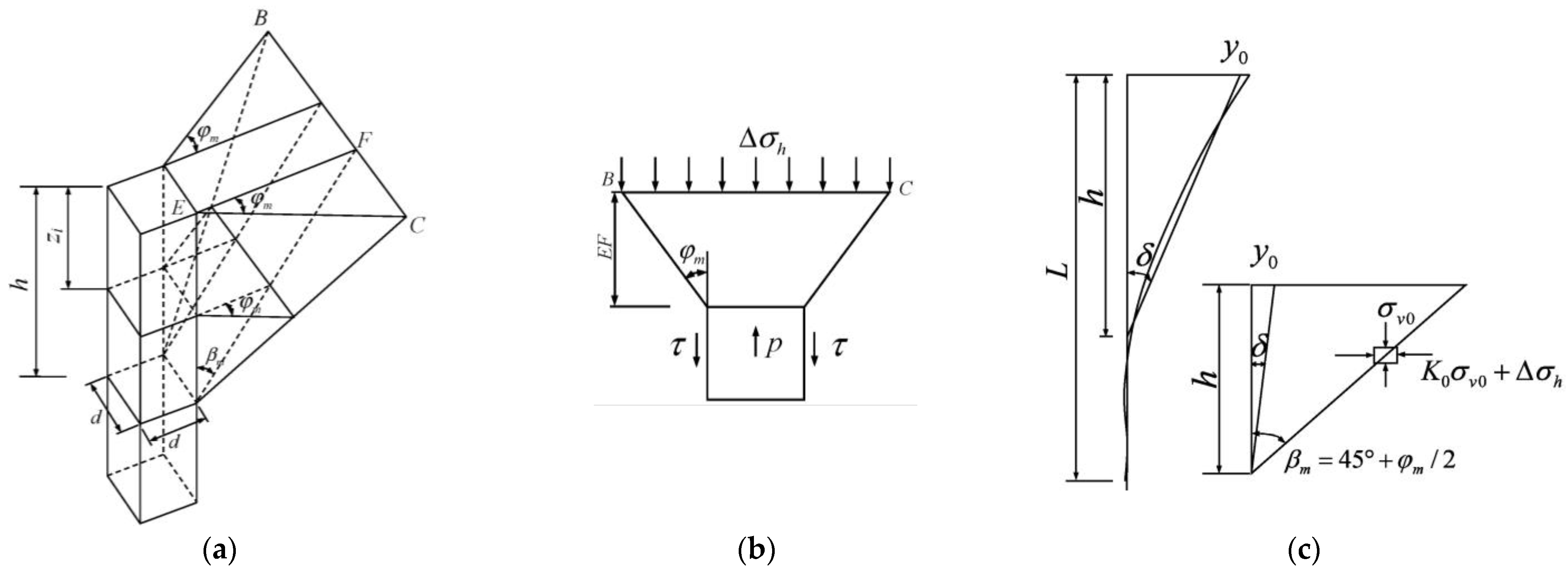
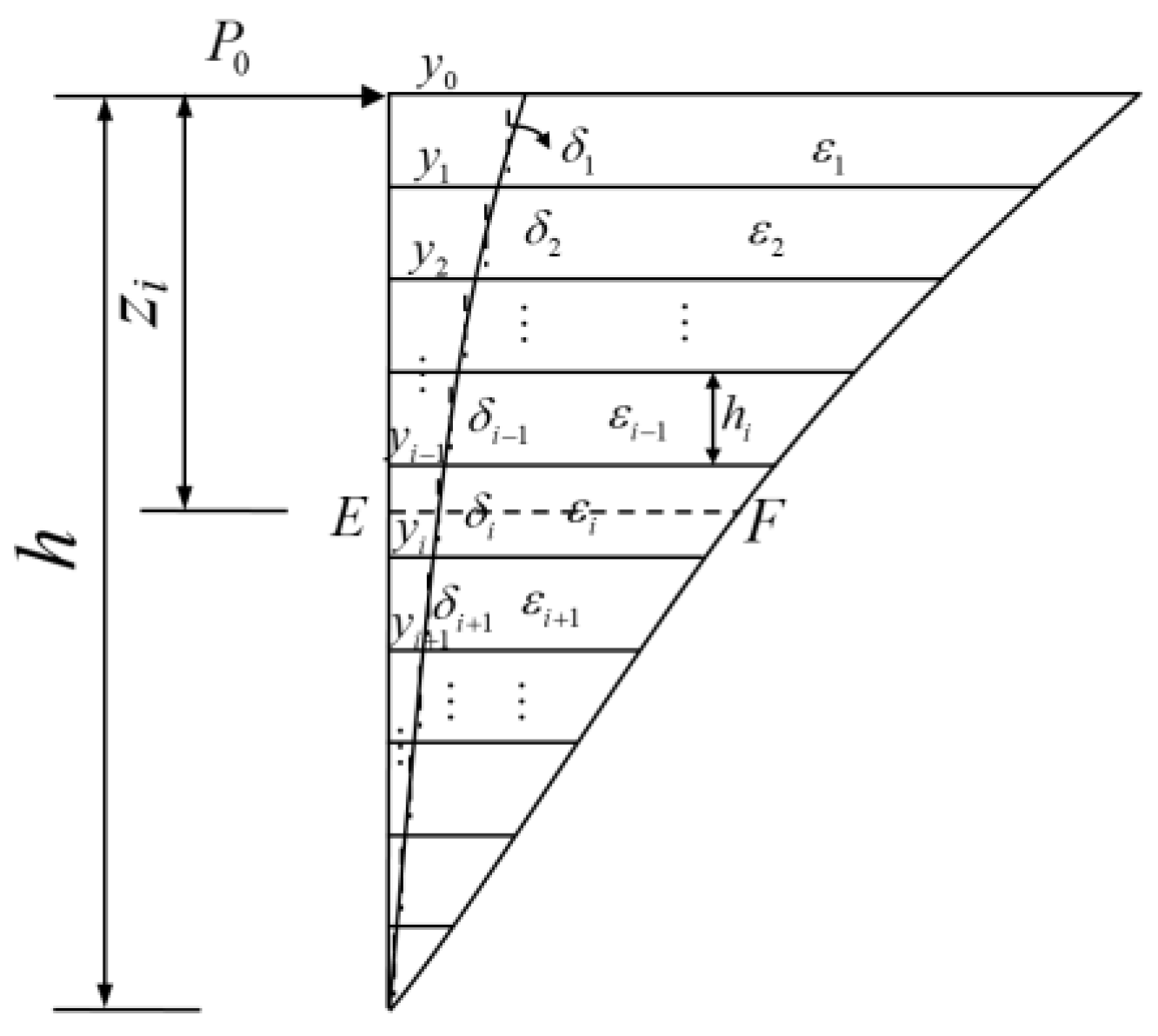

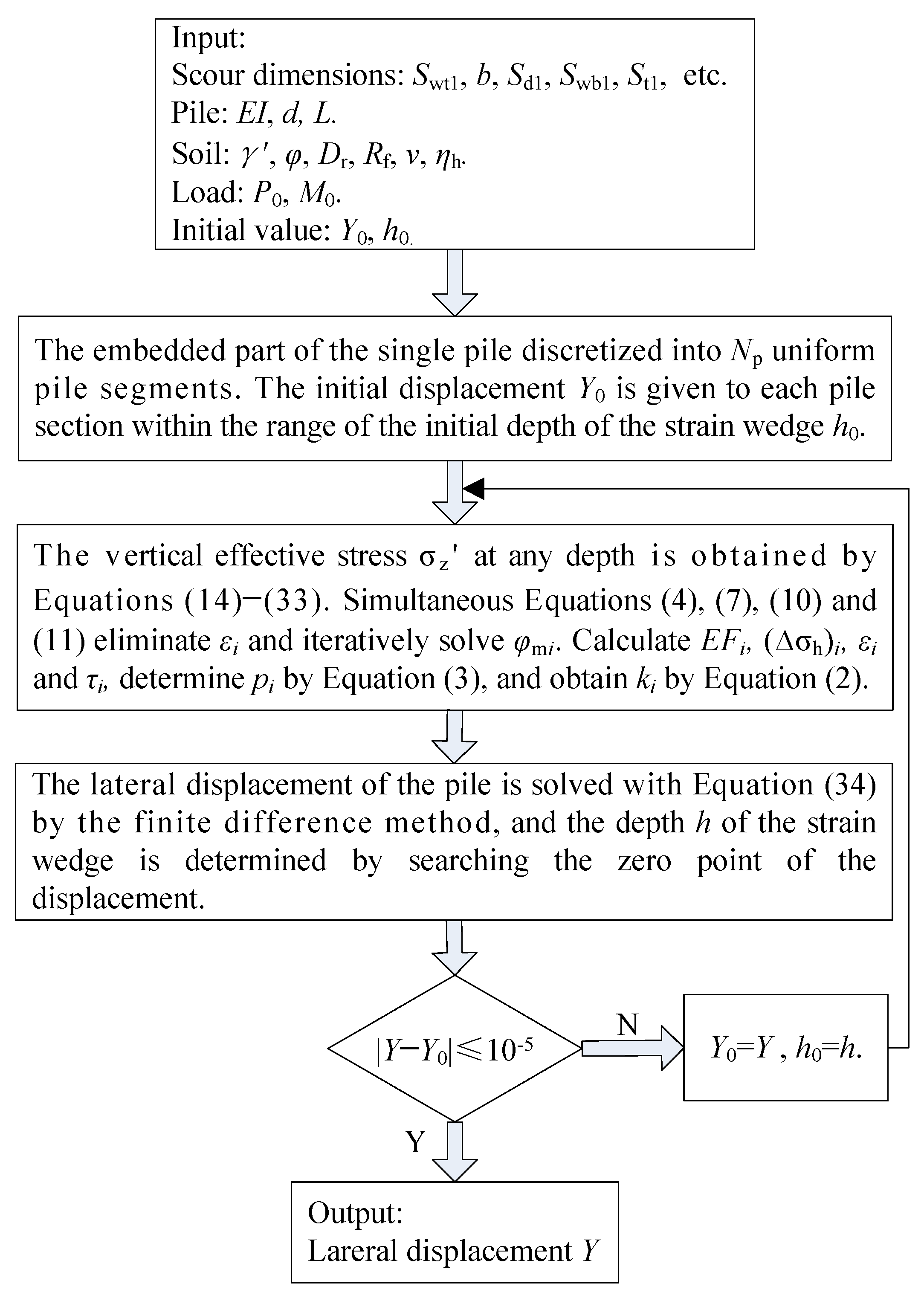

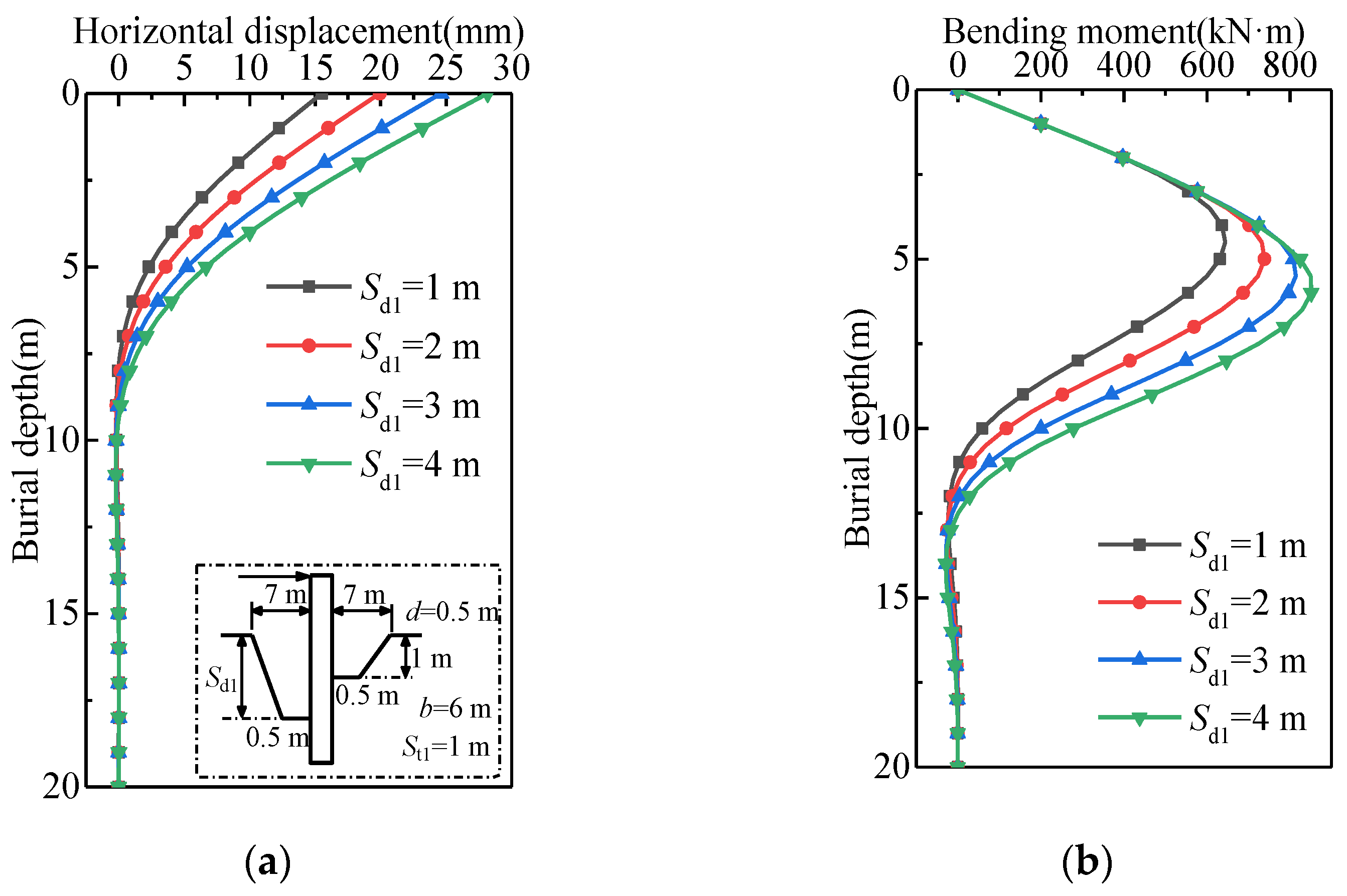
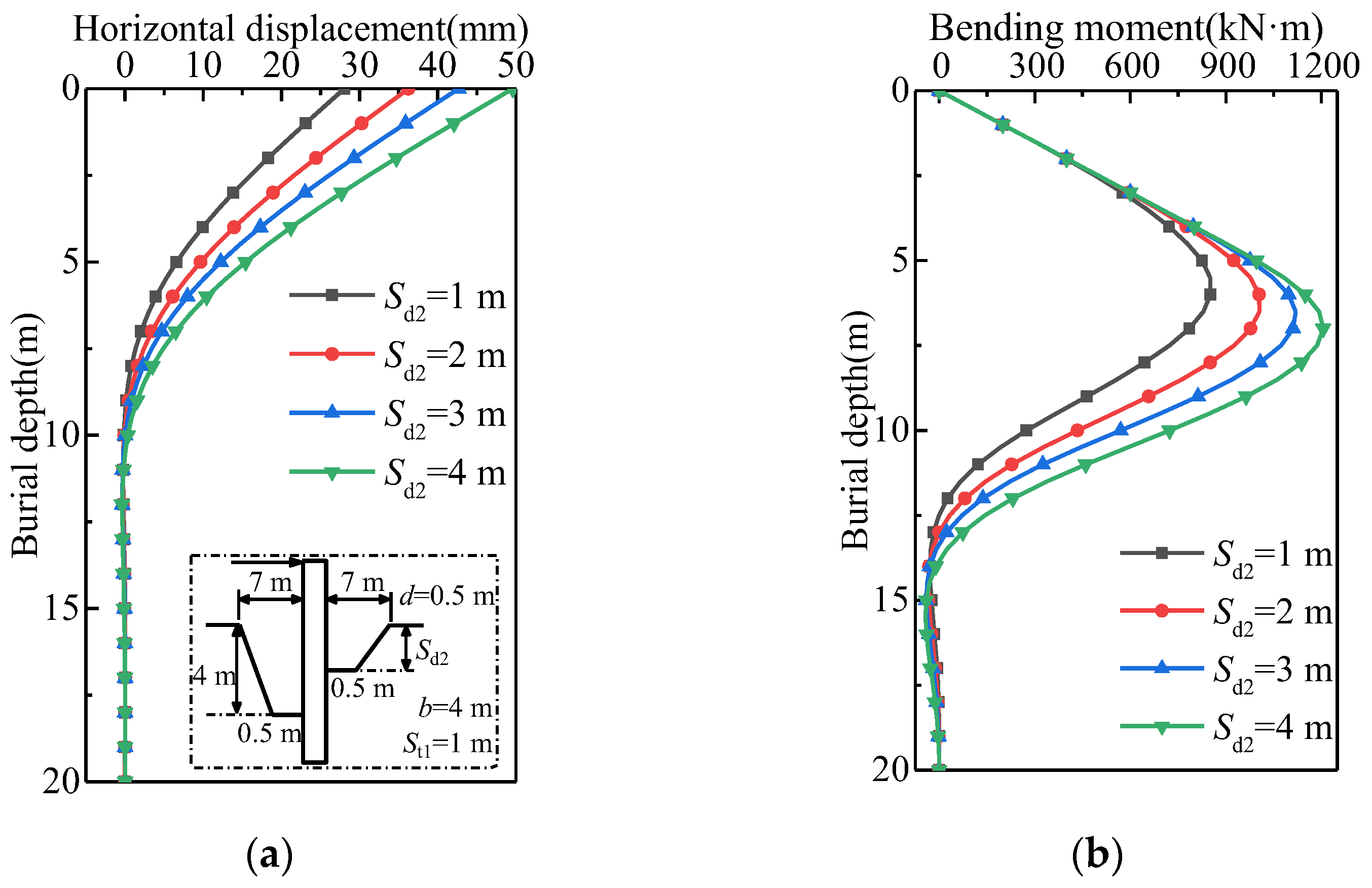
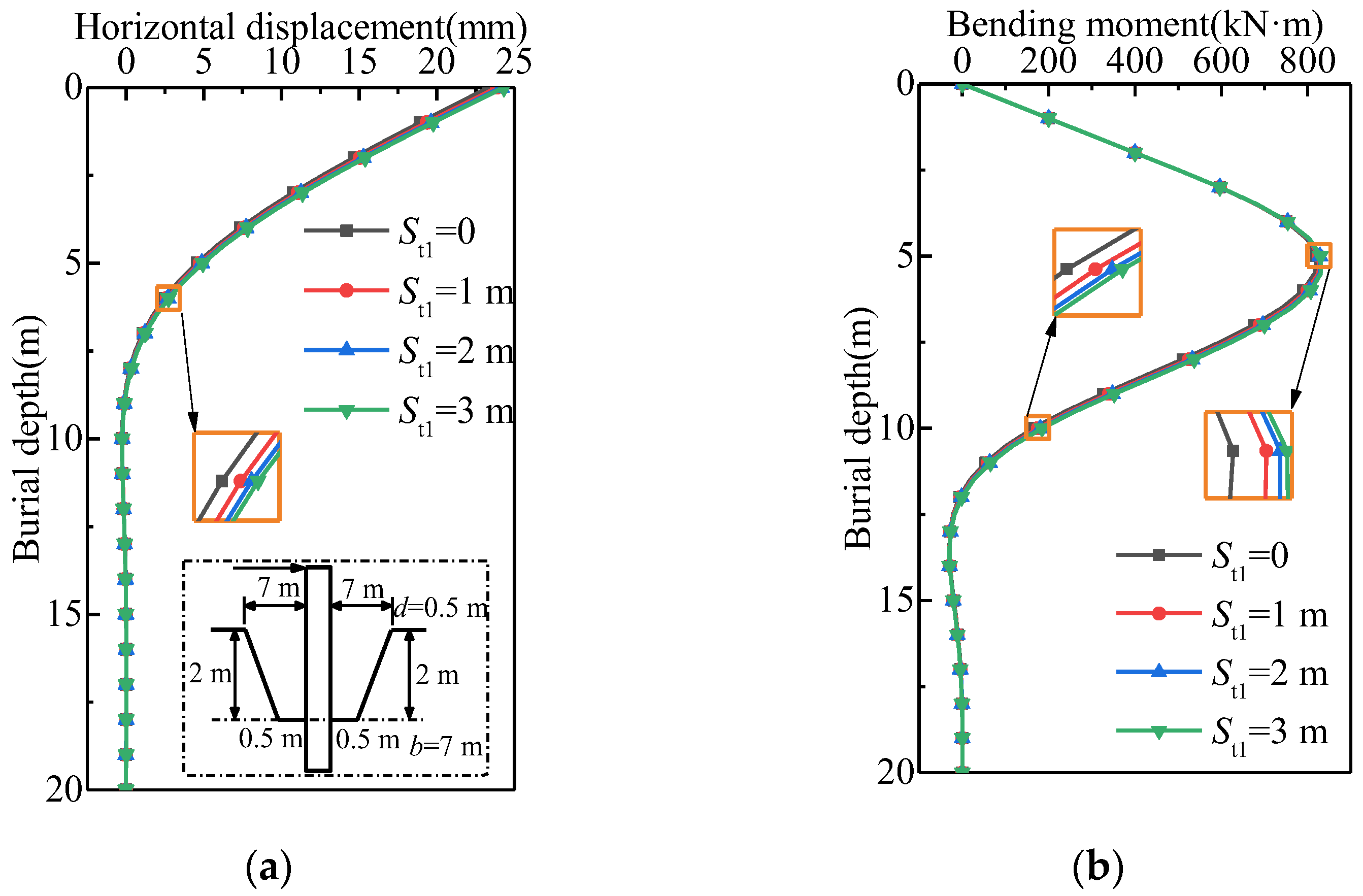
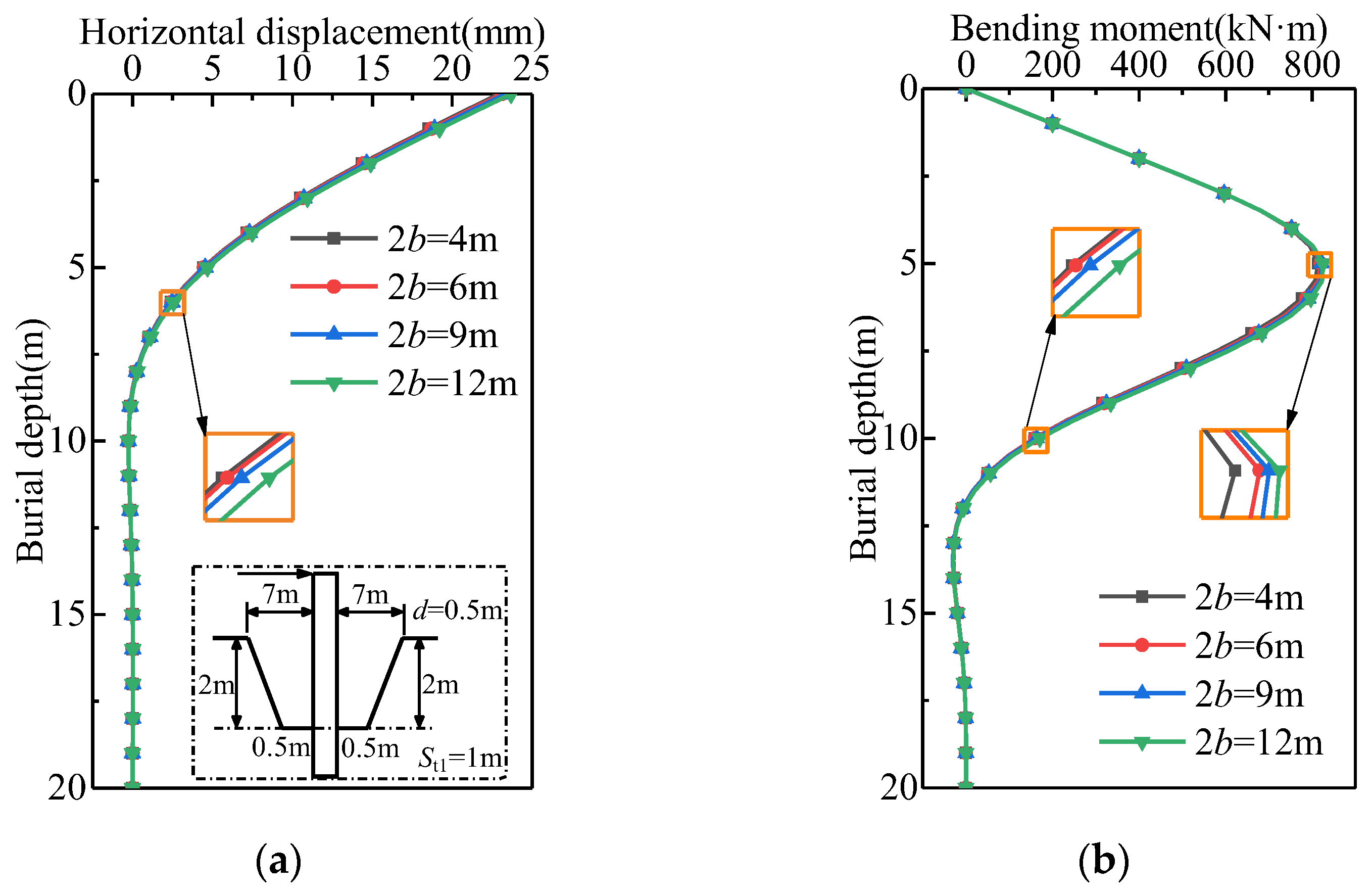
| Physical Meaning | Numerical Value |
|---|---|
| Lateral load at the top of the pile/kN | 200 |
| Length, /m | 20 |
| Diameter, /m | 0.5 |
| Flexural stiffness, /kN·m2 | 1.17 × 106 |
| Cohesive force, /kPa | 0 |
| Relative density, /% | 65 |
| Poisson ratio of the pile, | 0.2 |
| Poisson ratio of soil, | 0.25 |
| Physical Meaning | Numerical Value |
|---|---|
| Type of pile foundation | Steel pipe pile |
| Length, /m | 21.3 |
| Diameter, /m | 0.61 |
| Wall thickness, /m | 0.0095 |
| Flexural stiffness, /MN·m2 | 163.32 |
| Foundation type | Saturated medium-density fine sand |
| Effective gravity, /kN/m3 | 10.4 |
| Internal friction angle, /° | 39 |
| Relative density, /% | 60 |
| Poisson ratio of the pile, | 0.3 |
| Physical Meaning | Numerical Value |
|---|---|
| Width of upstream bottom of pile foundation, /m | 1 |
| Width of scour hole, /m | 7.46 |
| Slope of upstream scour hole of pile foundation, /° | 39 |
| Slope of downstream scour hole of pile foundation, /° | 39 |
| Slope on both sides of pile foundation, /° | 32 |
| Burial Depth (m) | Displacement (mm) | Bending Moment (kN·m) | ||||||
|---|---|---|---|---|---|---|---|---|
| 0 | 23.17 | 23.22 | 23.33 | 23.37 | 0.00 | 0.00 | 0.00 | 0.00 |
| 2 | 14.52 | 14.56 | 14.64 | 14.67 | 400.00 | 400.00 | 400.00 | 400.00 |
| 4 | 7.23 | 7.26 | 7.32 | 7.33 | 752.19 | 752.37 | 752.53 | 752.59 |
| 6 | 2.43 | 2.44 | 2.47 | 2.48 | 788.80 | 790.01 | 791.78 | 792.22 |
| 8 | 0.23 | 0.23 | 0.24 | 0.25 | 504.97 | 506.53 | 509.76 | 510.67 |
| 10 | −0.26 | −0.26 | −0.26 | −0.26 | 159.89 | 160.76 | 163.20 | 163.99 |
| 12 | −0.15 | −0.15 | −0.15 | −0.15 | −8.00 | −7.83 | −7.16 | −6.92 |
| 14 | −0.03 | −0.03 | −0.03 | −0.03 | −28.36 | −28.42 | −28.51 | −28.52 |
| 16 | 0.01 | 0.01 | 0.01 | 0.01 | −10.18 | −10.23 | −10.36 | −10.40 |
| 18 | 0.01 | 0.01 | 0.01 | 0.01 | −0.63 | −0.64 | −0.67 | −0.68 |
| 20 | 0.00 | 0.00 | 0.00 | 0.00 | 0.00 | 0.00 | 0.00 | 0.00 |
| St1 Value(m) | Additional Stress (kN/m2) | 2b Value (m) | Additional Stress (kN/m2) |
|---|---|---|---|
| 0 | 0.114 | 4 | 0.089 |
| 1 | 0.031 | 6 | 0.059 |
| 2 | 0.022 | 9 | 0.042 |
| 3 | 0.020 | 12 | 0.034 |
Disclaimer/Publisher’s Note: The statements, opinions and data contained in all publications are solely those of the individual author(s) and contributor(s) and not of MDPI and/or the editor(s). MDPI and/or the editor(s) disclaim responsibility for any injury to people or property resulting from any ideas, methods, instructions or products referred to in the content. |
© 2024 by the authors. Licensee MDPI, Basel, Switzerland. This article is an open access article distributed under the terms and conditions of the Creative Commons Attribution (CC BY) license (https://creativecommons.org/licenses/by/4.0/).
Share and Cite
Wang, S.; Ma, J.; Wang, C.; Liu, F.; Li, D. An Investigation into the Lateral Bearing Performance of a Single Pile Embedded at a Three-Dimensional Asymmetric Local Scour Site Using the Modified Strain Wedge Model. Appl. Sci. 2024, 14, 3056. https://doi.org/10.3390/app14073056
Wang S, Ma J, Wang C, Liu F, Li D. An Investigation into the Lateral Bearing Performance of a Single Pile Embedded at a Three-Dimensional Asymmetric Local Scour Site Using the Modified Strain Wedge Model. Applied Sciences. 2024; 14(7):3056. https://doi.org/10.3390/app14073056
Chicago/Turabian StyleWang, Songyang, Jianjun Ma, Chaosheng Wang, Fengjun Liu, and Da Li. 2024. "An Investigation into the Lateral Bearing Performance of a Single Pile Embedded at a Three-Dimensional Asymmetric Local Scour Site Using the Modified Strain Wedge Model" Applied Sciences 14, no. 7: 3056. https://doi.org/10.3390/app14073056
APA StyleWang, S., Ma, J., Wang, C., Liu, F., & Li, D. (2024). An Investigation into the Lateral Bearing Performance of a Single Pile Embedded at a Three-Dimensional Asymmetric Local Scour Site Using the Modified Strain Wedge Model. Applied Sciences, 14(7), 3056. https://doi.org/10.3390/app14073056








